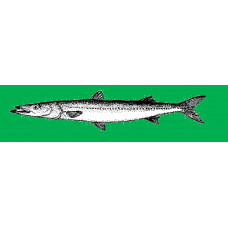Latin name
Sphyraena argentea
Other names
California barracuda, barry, snake, scoots, scooter; French: bécune argentée.
Identification
The Pacific barracuda has a slender build, a conical head, a long thin snout, and large fangs in the lower jaw that protrude beyond the upper jaw. It also has a forked tail, large eyes, and short, widely separated dorsal fins with five dorsal spines and 10 dorsal rays. The anal fin has two spines, usually followed by nine rays. It is grayish black on the back with a blue tint that turns silvery white on the sides and belly, it has a yellowish tail. Large females have pelvic and anal fins with charcoal-black edging, while males have yellow or olive edging.
Distribution
Pacific coast of America - from Alaska to Cape San Lucas, North of Conception Bay, is rare. The Pacific barracuda is the only one found on the Pacific coast of North America.
Habitat
Pacific barracuda prefer warm waters. Off the coast of California, they are caught in spring and summer. In Mexican waters, they are found year-round, reflecting a northward migration in the spring and a southward migration in the fall.
Size
The Pacific barracuda is shorter than the great barracuda. It has been reported that it can grow up to 5 feet, but only up to 4 feet has been reported. It rarely weighs more than 10 pounds; specimens have been caught weighing about 12 pounds. They live at least 11 years, with females growing larger than males.
Life history and Behavior
Spawning occurs off the outer shores of Baja California in the open ocean, peaking in June and lasting from April through September. The eggs are in pelagic waters, and after hatching, the juveniles come ashore and remain in shallow, quiet bays and coastal waters while they grow. When they are small, they roam in groups; adults are usually solitary. They are curious, attracted to shiny objects.
Food and feeding habits
The food consists of small gregarious fish, primarily sardine, anchovy, juvenile mackerel and mackerel.
Reproduction
Spawning takes place from May to July. Fish spawn in portions. The number of eggs depends on the size of the fish. The fecundity of 6-7-year-old females is 300-400 thousand eggs. The eggs are pelagic.
| Classification | |
| Phylum | Chordata |
| Class | Actinopterygii |
| Family | Sphyraenidae |
| Genus | Sphyraena |
| Species | S. argentea |
| Features | |
| Conservation status | Least Concern |
| Habitat | Littoral |
| Life span, years | 14 |
| Maximum body weight, kg | 5.5 |
| Maximum length, cm | 153 |
| Sailing speed, m/s | 11.1 |
| Threat to people | Edible |
| Way of eating | Predator |


